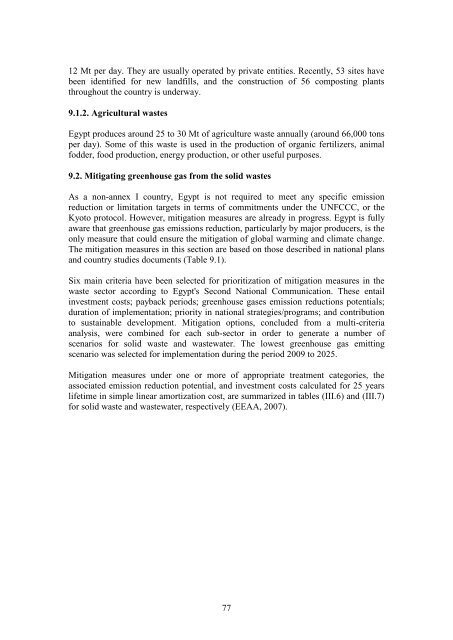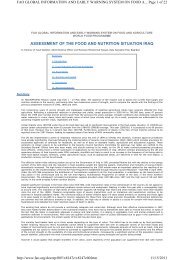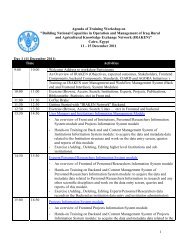Vermiculture in Egypt: - FAO - Regional Office for the Near East and
Vermiculture in Egypt: - FAO - Regional Office for the Near East and
Vermiculture in Egypt: - FAO - Regional Office for the Near East and
You also want an ePaper? Increase the reach of your titles
YUMPU automatically turns print PDFs into web optimized ePapers that Google loves.
12 Mt per day. They are usually operated by private entities. Recently, 53 sites have<br />
been identified <strong>for</strong> new l<strong>and</strong>fills, <strong>and</strong> <strong>the</strong> construction of 56 compost<strong>in</strong>g plants<br />
throughout <strong>the</strong> country is underway.<br />
9.1.2. Agricultural wastes<br />
<strong>Egypt</strong> produces around 25 to 30 Mt of agriculture waste annually (around 66,000 tons<br />
per day). Some of this waste is used <strong>in</strong> <strong>the</strong> production of organic fertilizers, animal<br />
fodder, food production, energy production, or o<strong>the</strong>r useful purposes.<br />
9.2. Mitigat<strong>in</strong>g greenhouse gas from <strong>the</strong> solid wastes<br />
As a non-annex I country, <strong>Egypt</strong> is not required to meet any specific emission<br />
reduction or limitation targets <strong>in</strong> terms of commitments under <strong>the</strong> UNFCCC, or <strong>the</strong><br />
Kyoto protocol. However, mitigation measures are already <strong>in</strong> progress. <strong>Egypt</strong> is fully<br />
aware that greenhouse gas emissions reduction, particularly by major producers, is <strong>the</strong><br />
only measure that could ensure <strong>the</strong> mitigation of global warm<strong>in</strong>g <strong>and</strong> climate change.<br />
The mitigation measures <strong>in</strong> this section are based on those described <strong>in</strong> national plans<br />
<strong>and</strong> country studies documents (Table 9.1).<br />
Six ma<strong>in</strong> criteria have been selected <strong>for</strong> prioritization of mitigation measures <strong>in</strong> <strong>the</strong><br />
waste sector accord<strong>in</strong>g to <strong>Egypt</strong>'s Second National Communication. These entail<br />
<strong>in</strong>vestment costs; payback periods; greenhouse gases emission reductions potentials;<br />
duration of implementation; priority <strong>in</strong> national strategies/programs; <strong>and</strong> contribution<br />
to susta<strong>in</strong>able development. Mitigation options, concluded from a multi-criteria<br />
analysis, were comb<strong>in</strong>ed <strong>for</strong> each sub-sector <strong>in</strong> order to generate a number of<br />
scenarios <strong>for</strong> solid waste <strong>and</strong> wastewater. The lowest greenhouse gas emitt<strong>in</strong>g<br />
scenario was selected <strong>for</strong> implementation dur<strong>in</strong>g <strong>the</strong> period 2009 to 2025.<br />
Mitigation measures under one or more of appropriate treatment categories, <strong>the</strong><br />
associated emission reduction potential, <strong>and</strong> <strong>in</strong>vestment costs calculated <strong>for</strong> 25 years<br />
lifetime <strong>in</strong> simple l<strong>in</strong>ear amortization cost, are summarized <strong>in</strong> tables (III.6) <strong>and</strong> (III.7)<br />
<strong>for</strong> solid waste <strong>and</strong> wastewater, respectively (EEAA, 2007).<br />
77





